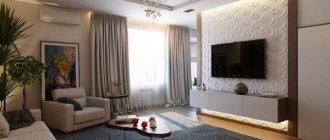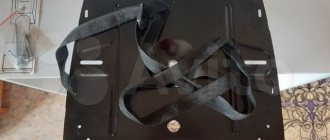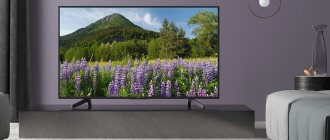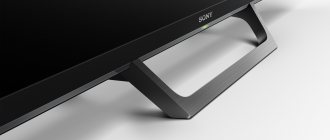SHARE ON SOCIAL NETWORKS
FacebookTwitterOkGoogle+PinterestVk
There are no strict rules that regulate at what height to hang a TV on the wall. However, there are generally useful recommendations from ophthalmologists and other experts that the user should keep in mind to ensure a comfortable and safe TV viewing experience. To install the TV correctly, it is necessary to take into account the purpose and dimensions of the room, the diagonal of the screen and the features of the situation in the room.
To hang the TV at the optimal height, it is recommended to follow certain recommendations
What factors influence the choice of the height of the TV on the wall?
There are several factors that influence the choice of location and height of the TV relative to the floor. The first of these is the size and purpose of the room. The interior design, selection and arrangement of furniture depend on these criteria. It is necessary that a paired socket for the device be located nearby, which should be located at a distance of no more than 45 cm from the bracket. This creates an aesthetically pleasing wall that is not cluttered with wires.
First of all, the height of the TV depends on the size of the device
The optimal location for installing the TV directly affects viewing comfort. To do this, it is recommended to take a comfortable position in the room and, based on your personal feelings, identify the wall where the device should hang.
According to the recommendations of experts, the TV should be located in a straight line between the viewing area and the wall where it is located. This space should not be overloaded with other interior elements, so as not to create some discomfort when watching TV.
The next important criterion is the screen size. The distance to the TV and the diagonal of the device are in a certain ratio. The larger the screen size, the further the unit should be located from the person’s seat and the higher it is in relation to the floor. The second factor is due to the fact that when the screen moves away, the viewing angle narrows significantly. This parameter is also influenced by the height of the armchair, sofa, chair or other piece of furniture from which viewing will be carried out.
What to pay attention to
A new TV always means positive emotions, pleasant hopes and anticipation of something incredibly interesting. All this, of course, is incredibly good, but in the wake of enthusiasm it seems very important not to make a mistake with its correct installation on the wall. To do this, you need to take into account the following factors:
- interior features
- the location of the TV should be clearly visible and should not be overloaded with unnecessary details; - the size of the room
is an important point that determines the location of the furniture for viewing; - the average height of family members
- everything is simple here: we add up the total “footage” and divide by the number of household members; - placement of the outlet
- any television receiver will require at least a pair of outlets, so pay attention to the distance to the nearest one if you don’t want to clutter the space with ugly wires; - dimensions of the device
- the larger the diagonal, the higher you can fix it on the wall, this is due to the fact that the viewing angle narrows considerably with distance; - furniture features
- the height of a sofa, armchair or any other furniture also affects the viewing angle, so not taking this information into account when deciding on the hanging height would be an unforgivable mistake.
Methods for determining the distance to the TV screen from the viewing point
There are two ways to determine at what level to hang the TV. The first is based on personal feelings. To do this, you should take a comfortable position at the viewing point. Although a comfortable posture can be sitting, reclining or lying down, the screen should be at eye level of the person viewing it. You need to close your eyes for a few seconds. When they are opened instantly, the gaze will fall on a certain point on the wall. This area should become the center of the screen.
The first way to determine the height of the TV is related to your own viewing sensations
With this method, the rule of dependence of the size of the TV on the distance to it is not observed. Therefore, if you completely trust this option, with a high degree of probability we can say that your eyes will get tired when watching.
The second option involves a mathematical calculation. Expert recommendations are taken into account. The screen should be at eye level. If it is lower or higher, the image will be distorted. The optimal distance from the eyes to the TV screen is a value equal to the diagonal size multiplied by 3. For plasma, the screen dimensions are multiplied by 4.
If you choose a 3D or LED viewing technique, then the screen resolution is also taken into account, which affects the image quality and viewing comfort level.
For screens with a resolution of 720p, the recommended distance to the TV is calculated by multiplying the diagonal value by 2.3. For 1080p devices, which cause virtually no visual impairment or eye fatigue, the screen size is multiplied by a factor of 1.6.
The second method involves the use of mathematical calculations
Considering both methods, it should be concluded that the TV should be located at a distance of 1-1.3 m from the floor. If the device is hung lower, the likelihood of mechanical damage to the screen and friction of various objects against it, which may be in the hands of children playing or passing by, increases. passing adults. For short people, the lower limit of the limit is selected. For household members with a height of 160-185 m, you should choose a value of 1.1-1.15 m, and for taller people, the upper limit is selected.
Important! When choosing the height of the TV relative to the wall, you also need to take into account the height of the seating furniture.
We hang the panel ourselves
If you decide to hang the TV on the wall yourself, prepare a drill or hammer drill. It is necessary to make a mark how far from the floor to hang the TV. A concrete or brick wall is very durable. It can support a weight of more than 30 kg. For drywall, this indicator is the limit. The package includes a set of hardware required for attaching the wall part of the bracket. It is enough to make a hole in the wall and secure the profile.
In masonry and concrete, a hammer drill and concrete drill are used to create a hole. In drywall or wood - a wood drill.
Then the 2nd part of the bracket is fixed to the panel, and the TV is mounted to the wall. After this, the installation is considered complete, you can start watching TV.
Useful recommendations from experts regarding the location of the TV
Thinking about what distance should be from the TV, most ophthalmologists came to a consensus. It is necessary that the device is at the optimal distance from eye level, which is calculated by multiplying the diagonal size by a factor equal to 2. The angle of deviation from the device should not exceed 30°. The optimal value is 15-20°. The lower this value, the better this arrangement is for the eyes. The minimum acceptable threshold is 10°. If it is lower, your eyes will be very strained when viewing the image.
To determine the optimal height of the device, ophthalmologists recommend multiplying the diagonal size by 2
The expanded viewing angle in width should not exceed 40°. Greater value is possible for myopic people. According to the recommendation of ophthalmologists, watching TV should be done in a sitting position with a straight back, which should be perpendicular to the floor, and the head may be slightly tilted forward. It is this position that minimizes the likelihood of developing myopia and scoliosis. The minimum safe distance from the floor to the TV must be at least 1 m.
Important! It is necessary that the middle of the TV screen is at eye level.
To install the TV on the wall, it is recommended to use inclined brackets. They will allow you to adjust the angle of the device while viewing and choose the most comfortable position for a particular situation. The mounting system must be designed strictly for the TV, as another option may not support the weight of the device. The brackets should be periodically tightened for more secure fixation.
What to consider when determining height?
The main task of a TV on the wall is to view it, that is, the height should be suitable for all viewers.
Therefore, first of all, evaluate - from what position do you plan to watch the programs? If this is a sofa, then you need to take into account the standard position of a person - sitting or reclining. Place the TV screen at eye level. What are the dangers of improperly installing the TV:
- Higher than necessary. The head is constantly thrown back, the neck muscles are tense. Headaches and cramps occur.
- Lower than necessary. Head down. Pain in the cervical spine and headaches may occur.
- Closer than necessary. Sitting too close means increasing the strain on the eyes several tens of times, which will lead to deterioration of vision.
- Further than necessary. You will have to constantly strain your eyesight, it will be uncomfortable, you won’t be able to see the details.
The distance from the seat to the screen is no less important than the height from the floor. Classic formula:
Screen distance = Display diagonal*2
That is, for a 48” panel (corresponding to ~122 cm), the gap is 244 cm.
Basic rules for placing a TV:
- position the display so that the center line is opposite your eyes;
- install a bracket with adjustable position if you want to watch broadcasts from different places;
- do not place the TV on the wall above appliances that emit heat (fireplace, radiator, hob);
- take into account the height of the household, the height of the furniture seats, when calculating the distance from the floor - the average value is 80-120 cm.
The TV is placed above the floor in two ways:
- On furniture. Or inside it (in a niche in a wall, slide). The method is less flexible regarding changing sizes - you need to calculate in advance at what level the niche should be located, what width and height it should be for your equipment. When placing it on top (on a chest of drawers, a nightstand, a special module), also first evaluate the recommended height, and then buy a stand.
- On the wall. Special brackets are used for hanging. A suitable model is selected according to VESA parameters, that is, the horizontal and vertical distance between the bolts must be the same on the mount, on the back panel of the TV. Brackets can be static (suitable for a clearly defined location in rooms when the TV does not need to be moved or tilted), inclined (an excellent option if you need to install the TV above a suitable level), tilt-rotate (needed for several viewing locations - in studios where one the screen should be visible from the sofa, kitchen, bed), lifting (can change direction vertically, horizontally).
Calculating the diagonal height of the TV
The screen resolution determines the optimal distance and optimal height. One value will not be enough; it is important to take into account the image resolution. You can independently calculate the recommended placement height using the formula:
Diagonal * k, where k is a coefficient equal to 2.3 for 720p, 1.6 for 1080p.
For example, to hang a 48-inch TV with 1080p quality, we use the formula: 48*1.6=76.8. This is the optimal height to the center of the screen. The only caveat is that this standard only works to determine the height of the TV in the living room; it is best suited for large panels larger than 40 inches. The larger the equipment, the higher it needs to be secured.
In order not to calculate the dimensions yourself, please refer to the table of recommendations:
| Diagonal, inches | 720p TV height to bottom, cm | 1080p TV height to bottom, cm |
| 40 | 92 | 65 |
| 43 | 99 | 70 |
| 50 | 115 | 80 |
| 55 | 127 | 88 |
| 58 | 133 | 93 |
You can check how accurately you have determined the height and range using a simple technique. Take a sheet (or several sheets) the size of your TV - attach them to the wall in the intended place, sit in front of it for a few minutes. To be convincing, you can write or draw something on paper - this way you can check the ability to read small text or examine details, for example.
Mounting options for hanging TV
To securely place the plasma on the wall, it is important to choose the right quality fasteners. There are several options for TV brackets: rigid, inclined and universal. The first type of mount ensures that the TV is fixed in one position. The device will not be able to be rotated or bent. The TV is placed close to the wall, while ensuring a minimum ventilation gap.
For mounting TVs to the wall, inclined, rigid and universal brackets are used.
Important! When selecting a bracket with rigid fixation, there is no room for error in choosing the optimal height of the TV relative to the floor.
The tilt bracket allows you to tilt the TV vertically, while adjusting the viewing angle. This is very convenient when changing body posture while watching TV. Using the tilting bracket, you can choose a comfortable screen position when watching a program or movie while lying down, which is especially important if you place the TV in the bedroom. There will be a ventilation gap of 7-10 cm between the device and the wall.
The universal type of bracket is considered the most complex fastening option. Its special device allows you not only to tilt the TV horizontally, but also to rotate it to the right or left. This type of bracket is the most expensive in comparison with previous analogues.
Helpful advice! When the question arises of how to hang a TV in a corner, a universal bracket comes to the rescue.
Universal brackets are the most expensive, but at the same time the most optimal
The process of installing a TV on the wall is a fairly simple undertaking. To do this, you will need a hammer drill and the selected fastening element. Any model of bracket is equipped with the necessary set of fasteners to securely fix the device to the wall.
Types of fasteners
Don't know how to properly hang a TV on the wall? Start by reviewing the available fasteners. Mostly users buy three types of brackets:
- with rigid fixation;
- with vertical slope;
- multifunctional.
The easiest way to hang your TV correctly is to use a universal bracket. This is the most convenient and expensive type. Rigid and inclined fasteners are installed only by those users who are confident that they will not be rearranging decorative items or furniture in the near future. Let's look at each type of bracket and highlight its strengths and weaknesses.
Rigid type mounts require a slight gap for the TV ventilation holes. We are talking about a gap of only a few centimeters. The device will be “tightly” fixed. The user does not have the opportunity to change the viewing angle in the future.
Inclined mounts are purchased to install the TV on the wall in the bedroom. After installation, you will be able to adjust the screen position vertically. This is very convenient when viewing is carried out from different points. For example, during the day from a sofa or chair, and in the evening from bed. Between the wall on which the device will hang and the back panel, you need to leave a distance of 10 centimeters.
Universal movable brackets are an expensive but practical solution. The name speaks for itself. You can hang the TV in the living room or bedroom. The user will be able to set the angle of inclination and also adjust it if such a need arises. The screen can be rotated left and right to enhance viewing comfort.
If the TV is mounted using a universal bracket, you should not skimp: the presence of an impressive number of movable modules requires appropriate quality bolts and metal. The weight of the device exerts constant pressure on the structure. Therefore, saving in this case is not a practical solution.
Which mount is best to choose to hang a TV in a corner? Any bracket will be suitable for this task, but a universal one will be the priority choice.
How to determine a place to install a TV on the wall in the living room
The choice of height for placing the TV on the wall also depends on the purpose of the room. The device can be installed in any room. If it is the only one, it will most likely be placed in the living room. This is mainly the largest room in the apartment, where the whole family gathers to spend time together. Guests are received here and ceremonial feasts are organized. Deciding where and at what height to hang a TV in the living room should be based on ensuring maximum comfort for all family members when watching their favorite programs from different points in the room.
The installation location is determined based on the location of the furniture. The TV is most often installed on the wall, opposite which there is a soft corner, sofa or armchair. If there are several windows in the room, the TV is placed on a blank surface. If you hang it between window openings, it will cause inconvenience, as glare of light will be reflected in it.
Most often, I place the TV in the living room opposite the armchairs or sofa.
Do not place the TV near a fireplace or other heating devices. It should not be exposed to direct sunlight. It can become very hot, which will negatively affect its operation and reduce its service life. The distance from the fireplace to the TV should be at least 1.5 m. You can conduct an experiment and measure the temperature first near a cold fireplace, and then during its operation. At a distance where it has practically not changed, you can install equipment.
At what height to hang a TV in the living room: useful recommendations
To determine at what height from the floor to hang the TV in the living room, you should sit comfortably and look directly at the wall. The head should not be thrown back so as not to create stress on the cervical spine. The direction of the eyes will point to a point that should become the middle of the screen.
Important! The center of the TV screen or its upper third must be located opposite the person’s eyes.
The optimal distance to the TV from the floor for the living room is 1.4-1.6 m. The height of the upholstered furniture and the average height of family members are also taken into account. With a standard sofa height, the optimal screen level for children and adults will be different, so the average height of the TV is determined.
The TV in the living room is hung at a height corresponding to the eye level of a sitting person.
If you plan to watch TV from the sofa, you can position it slightly below the recommended level. If the hall is combined with a dining room, and watching programs is often done while sitting at a table, the unit can be hung a little higher.
Helpful advice! The larger the diagonal size of the TV, the lower it should be placed relative to the floor.
Many people install the TV in special furniture niches. However, this decision is not always correct. Here, the size of the screen and the height of the sofa from the floor are also taken into account. An imbalance may occur, causing discomfort while viewing.
To mount the TV in the living room, it is better to give preference to a universal bracket, thanks to which you can adjust the position of the screen both vertically and horizontally.
The average optimal height for a TV in the living room ranges from 140 to 160 cm
Choosing a place for plasma
To determine at what distance from the floor to hang the TV, initially decide for which room you are purchasing the equipment. The recommended height will be different for each room. So, for example, in the living room, where all household members gather, they most often watch TV while sitting on the sofa or in an armchair. And in the bedroom they prefer to relax while lying down while watching programs.
What to consider: 6 rules
Plasma and LCD TVs are more convenient to hang on the wall. This allows you to significantly relieve space and provide lightness to the interior. To properly hang a TV on the wall, you need to take into account six rules stated by the manufacturers.
- Find a helper. TVs are quite heavy, weighing on average 25 kg. Therefore, you need two people to hang equipment - one person simply physically cannot cope.
- Entrust the matter to a specialist. If you've never picked up a drill before, don't tempt fate. Invite a competent specialist who will quickly and correctly hang the plasma on the wall. Thus, it will protect you from injury, and the new equipment from falling.
- Use free space. A TV mounted in a niche looks quite original. However, manufacturers strongly recommend leaving free space on all sides so that air flows can circulate freely through the special ventilation holes provided in the equipment.
- Check the wall for compliance. Don't forget that TVs are not only large, but also quite heavy. Before hanging equipment on the wall, make sure it can support the heavy structure. It is strongly not recommended to hang a TV on drywall; the material is simply not capable of supporting heavy weight.
- Take care of cable routing. Initially, hang the TV on the wall. And when the equipment is installed correctly, take care of connecting communications.
- Buy a movable bracket. This device allows you not only to install the equipment in any place you choose, but also provides comfortable viewing from any area of the room. After all, the bracket makes it possible to rotate the TV and adjust it to each household member. However, with any rotation of the bracket, the wire should not be stretched - failure to comply with the rule can lead to a fire.
Don't forget to consider the lighting level in the room. If you hang the TV on the wall opposite the window, you will only be able to watch it at night. Or you will have to buy thick blinds to protect from sunlight.
Room and screen dimensions
When choosing a place for the plasma, you need to take care of the safe viewing of movies or TV shows. Incorrect installation can lead to headaches, chronic fatigue, and cause visual impairment. To avoid this, choose your TV based on the size of the room. The distance from your eyes to the screen should not exceed the maximum permissible value and cannot be less than the recommended minimum distance. The optimal numbers are shown in the table.
Table - Recommended distance for watching TV depending on screen size
| TV diagonal, inch | Distance from screen to eyes, m |
| 70 | 2,7-4,5 |
| 65 | 2,5-4,1 |
| 58 | 2,2-3,7 |
| 55 | 2,1-3,5 |
| 52 | 2,0-3,3 |
| 50 | 1,9-3,2 |
| 46 | 1,7-2,9 |
| 42 | 1,6-2,7 |
| 40 | 1,5-2,5 |
| 37 | 1,4-2,4 |
| 32 | 1,2-2,0 |
| 26 | 1,0-1,7 |
At what height to hang a TV in the bedroom: room features
The location of the TV directly depends on the parameters of the bed, namely its height. To decide at what height to hang the TV in the bedroom, you need to take a comfortable position on the bed, close your eyes and relax for a while. When you open your eyes, you should intuitively mark a point on the wall, which should become the center of the device screen. The best option is to install the TV in the bedroom on the wall at a height of 1-1.5 m.
Helpful advice! The TV should be installed above the point of fixation of direct gaze in a standing position for a lying position.
In this case, the TV will be installed higher than in the living room. However, you should remember that you should not exceed the angle of deviation of the screen from the center when watching TV. The optimal value is 30°. Otherwise, problems will arise with the cervical spine, which will lead to osteochondrosis.
Related article:
How to hang a TV on the wall: tips for proper installation
Choosing the optimal location, height and location. Which bracket do you prefer? Advantages of wall mounting. Installation features.
The plane of the screen should be perpendicular to the line of sight. If a person watches TV in a lying position, with his head thrown back on the pillow, the monitor must be raised to the height of his gaze, while tilting the upper edge of the device away from the wall. In this case, the screen can be placed under the ceiling.
The height of the device in the bedroom depends on the position in which you plan to watch TV
In the bedroom, the TV can be attached to the ceiling. However, it does not have to be installed near the wall opposite the head of the bed. The device can be located directly above the bed. In this case, it is important to choose a reliable type of bracket.
The TV in the bedroom should be hung on an inclined bracket, which will allow you to adjust the angle of the screen in the vertical plane. You can choose a tilt-and-slide or tilt-and-swivel type of product. Its middle is attached at a distance of at least 160 cm from the floor. The question often arises at what height to make a TV outlet. On the wall, the outlets should be located above the bracket at a distance of 25 cm.
It should be remembered that LCD TVs are too sensitive to vertical tilts. If the monitor is positioned too low, the picture will be dark, while a high placement will result in a very light image.
How to install the bracket correctly
After purchasing a TV, you need to find the best place to install it. Experts do not recommend placing the device in a confined space. Otherwise, the air will not be able to circulate well. The situation is dangerous, because it can lead to overheating of the device. So, if you plan to hang the TV in a niche, then it should not be too cramped for it. There should be at least 20 centimeters at the top and bottom. The same gaps should be left on the other two sides.
Built-in niche for TV
It is of great importance what load the wall on which you place the equipment can withstand. It must be dense and of high quality.
If the wall is made of plasterboard, then no more than 35 kg can be placed on it.
To install the bracket you will need to use dowels. If the TV is heavy, then wall mounting is not advisable. If there is no other installation option, you will need to seal the wall with a plywood sheet.
Brackets are most often used for hanging TV
When using brackets, you should consider the following nuances:
- It is most convenient to install it on a hinged device.
- If you plan to mount a new TV on the wall, then the stand should also not be used.
- You need to choose a bracket depending on the type of TV. Dimensions and weight are also taken into account.
- If in doubt, it is recommended to ask the seller any questions you may have. He has extensive experience in this matter, so he will be able to select the best bracket.
The bracket can also move vertically and horizontally
- Mobility is key for a spare part. It can be rigid or allow you to adjust the rotation and tilt.
- It is recommended to use this part only if the TV is light in weight. With rigid fixation, there is no room for maneuver, but a more reliable fixation is provided.
Rigid bracket
Tilt bracket
Universal bracket
The bracket must have detailed instructions indicating the principle of fastening. If the necessary information is not there, you can ask the seller questions. Only after this is it possible to proceed to installing the part on the wall.
Installation of the bracket can only begin if the person is sure that there is no wiring on the site. You can check whether the wires are passing under the finish using special instruments.
Installing a TV on a plasterboard wall
You can easily lay a special channel on a plasterboard wall in which you can hide the cable.
To do this, you will need to make an exit for the cable at the bottom of the wall and continue running it under the plinth of the room. Forming a hole in a wall from this material does not require much effort. This will only take a few minutes. There won't be much dirt left after the process is completed either.
It is advisable to install a socket directly under the device only if the monitor is mounted on a bracket with the ability to move.
Thanks to this system, you can get easy access to the outlet.
Cables can also be hidden in a special box that will be located on top of the wall
In this case, the width of the connecting elements is taken into account. Some owners prefer to repaint them to match the color of the wall. Thanks to such a simple manipulation, it is possible to reliably disguise them. Contrasting coloring looks bold and unusual.
Additionally, you can also apply a special painting or cover it with mirror paper. In any case, you should not limit your imagination. If you don’t have confidence in your own abilities, then it’s best to abandon unusual projects.
Concrete wall mounting
If the wall is made entirely of concrete, then it is also not recommended to groove it. You can return to this option only if you plan to carry out a complete renovation in this room. In this case, the location of the TV will need to be decided in advance.
Drilling a concrete wall under wires should only be done during major repairs.
If the exterior design does not suit the owner, then you can make an external structure from plasterboard. It will protrude slightly against the background of the wall. The structure will allow you to hide the cables and not draw unnecessary attention to them.
A niche can only be used if it is spacious enough to accommodate a TV. Cables can be hidden in holes that are prepared in advance in the wall. They can be placed on the side or bottom.
Drywall niches will help hide wires
Builders recommend choosing to implement the idea with a ledge.
Thanks to this, the TV will be able to receive the required amount of air. It will circulate naturally and prevent overheating. You can make special racks or shelves on both sides. In the interior they will perform a decorative function.
Option for designing a niche for a TV made of plasterboard
Plasma or LCD TVs are found in almost every home. They do not take up much space in the interior. However, after purchasing the device, you will need to resolve the issue of its installation. Wall hanging is considered the optimal solution, because it helps to significantly save space. In this case, the TV can become a real wall decoration. You can place shelves or racks nearby that will attract attention.
Wall mounting of the TV is suitable even for retro style. The device looks like a painting. Some owners prefer to frame it. For this you can use polyurethane moldings. They are inexpensive, but look quite impressive. You can place a flower pot or sconce near the frame. The combination with an antique watch looks unusual. However, all interior details must be compatible in size. Otherwise, balance will not be achieved in the design.
At what height should you hang a TV on the wall in the kitchen?
TV in the kitchen is more often listened to while cooking than watched. When choosing its location in a room, you should take into account the area of the room and the distance of the device to the owners’ workplace. The placement of the monitor should not pose a danger to others, this is especially important if there are children in the house. The device can be installed on the bedside table, above the refrigerator and on the wall.
When placing the TV in the kitchen, take into account the size of the room and the distance to the viewing point
Helpful advice! The TV in the kitchen should not be placed near the sink, kitchen appliances, heating radiators or opposite windows.
When choosing at what height to hang a TV in the kitchen, you should proceed from whether the device will be placed at eye level of a person sitting at the table to ensure viewing while eating, or whether its central zone will be at eye level to someone standing. The optimal value can vary between 1-1.8 m.
In a small kitchen, it is better to place the TV as high as possible relative to the floor. The optimal distance from the floor to the TV on the wall is 1.75-1.8 m. The brackets must be fixed to the wall using metal anchors.
It is recommended to choose a tilt type mount that allows you to adjust the angle of the screen. It is better to give preference to models that have the ability to change the angle of rotation by 15-45°, horizontal or vertical movement by 5-50° and tilt by 15-30°. This is due to the fact that the TV in the kitchen is usually located at a height convenient for viewing while standing. When sitting, the image may be distorted. On LCD monitors the picture will be dark. An inclined type bracket can solve this problem.
If the TV is installed to view people sitting at a table, then it is necessary to take into account the location of the eye level
Important! In the kitchen, it is not recommended to install a TV in a furniture niche, which is due to the peculiarities of the microclimate in the room, which is characterized by high humidity and temperature changes.
How to hang a screen in the bedroom?
The distance from the floor in the bedroom and in the nursery is measured to the middle of the screen. It is usually placed opposite the bed. It is important to take into account that it does not interfere with comfortable movement around the room. When determining at what height to hang a TV in the bedroom, you should take into account the size of the screen and the distance from the bed from which you usually watch programs and movies before going to bed. Experts believe that the optimal size would be 130 cm at a distance of 4 diagonal sizes. In this case, sitting on the sofa and lying down, the angle of view will not exceed 30°.
TV size chart
For ease of viewing from different positions, it is convenient to use a mount that allows you to change the position of the screen and rotate it around a horizontal axis. In this case, you can minimize the angle between the monitor plane and your eyes.
Features of installing a TV in a children's room
When choosing a place to install a TV in a children's room, you should focus on the age and height of the child. The position of the monitor should not create obstacles during the child’s active games. If the TV is hung too low on the wall, it may cause injury to the baby.
The child will watch cartoons from different positions, so the image on the screen must be of high quality both for a child lying down and for a child sitting on a bed or chair. Here you should take into account the characteristics of the child’s postures. An important factor is the location of furniture and toys. The optimal height is considered to be 1.2 m. The normal distance to the TV from the sofa or bed for a baby is considered to be 2-2.5 m.
When installing a TV in a nursery, you need to take into account that the child will watch it in different positions
A prerequisite for a child’s room is to mount the device using a universal bracket, which allows you to adjust the position of the screen depending on the child’s location and position. This will make it possible to ensure not only comfortable but also safe viewing of TV, eliminating strain on the eyes and spine.
A good solution would be to place the TV on the wall in the corner. Sockets should be placed as high as possible so that a child cannot reach the wires and antenna cable.
What is a kitchen touchpad on Android system?
A unique new product on the world market is a 22-inch Android touch panel built into kitchen furniture on the Android operating system with Wi-Fi and Bluetooth functions, as well as a built-in camera. This touch panel uses a protective front surface made of tempered glass, which is easy to clean with special detergents (non-abrasive) and is not afraid of greasy stains.
This model is designed specifically for lovers of smart technology. With its help, you will always stay up to date with the latest news, exchange rates and traffic conditions thanks to widgets displayed on the screen. The touch panel for the kitchen will also help you control all smart home systems without using your phone. You can quickly turn on a smart kettle or robot vacuum cleaner, as well as any other gadgets controlled via Wi-Fi or Bluetooth. Thanks to the built-in camera and microphone, you can communicate with loved ones, friends or colleagues without stopping cooking or eating. In addition, any applications available on the Google Play Market will now be in your kitchen.
Today, this is the only model of a large tablet computer that is built into standard kitchen cabinets using lifting mechanisms and does not take up extra space. A touch panel for the kitchen is a real breakthrough in built-in appliances!
TV wall design
Choosing the right wall for a TV screen is the first thing a person who decides to hang a TV set needs to do. If the room is rectangular, then you need to mount the TV screen on a long wall, while correctly determining the height from the floor level and calculating the distance to the viewer’s eyes. The TV receiver in the room is an accent piece, so incorrectly decorating the wall on which it is placed will spoil the interior of the room. Thus, before installing the device, you need to decide how to decorate the wall with the TV.
To decorate the wall with a TV in the living room, the following materials can be used:
- Wallpaper. Stylish, inexpensive material that is painted in various colors. They allocate an area for equipment or decorate the entire wall. 3D wallpapers would also be a good solution. At the same time, they must be in harmony with the design of the room.
- Enamel. The paints are resistant to external influences and last a long time, have rich colors, so decorating a wall with them for a TV in the living room is a good solution. The area near the television receiver is done in warm colors; bright shades are added to highlight the object. Around the TV screen in the empty areas you can draw whatever the owner of the room wishes - plants, animals, etc.
- Textile. This material makes the room comfortable and cozy. It is recommended to use only natural fabrics that are in harmony with furniture or other interior items made from fabrics. The contrast between the color of the TV receiver and the textiles looks very interesting.
- Decorative plaster allows you to make a wall voluminous and textured and divide it into several zones that differ in texture. For example, you can hang a TV set on the flat part, and the textured part will become an interesting decoration.
- Bamboo. Natural, environmentally friendly, inexpensive and high-quality material, perfectly combined with various interior items and electronic equipment, will be a good idea for designing a wall with a TV.
- Stone and brick are great for decorating a wall with a TV screen. A brick or stone wall goes well with a fireplace.
The wall with the TV should not have flashy or flashy colors. It is better to choose white, cream, beige, pastel colors. If the dimensions of the room allow, the wall is painted black. By placing the TV on the wall in the living room, you can effectively use the furniture. The device can occupy the central part of a furniture wall or be built into a full-length wardrobe to save space.











